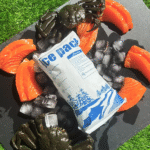Emballage de glace carbonique Pack de glace carbonique: Ce qui fonctionne 2025?
En utilisant dry ice packaging dry ice pack correctly keeps frozen goods solid through real‑world delays and depot dwell. This guide gives you field‑tested sizing rules, packing SOPs, et 2025 compliance notes you can apply today. You’ll learn how to choose the right box, where to place the packs, and how much to use for 24–96 hours of protection without guesswork.
-
Comment dry ice packaging dry ice pack compares to gel and PCM across seasons
-
How to estimate quantity with a fast, lane‑based method you can run on paper
-
How to pack step‑by‑step so cold sinks and hotspots vanish
-
Lequel 2025 regulations matter for dry ice packaging dry ice pack by air and ground
-
How to cut cost per order without raising claim risk
-
Quoi de neuf 2025: matériels, capteurs, and greener liners
What is dry ice packaging dry ice pack, et quand faut-il l'utiliser?
Réponse rapide: Dry ice packaging dry ice pack means pairing a vented insulated shipper with solid CO₂ packs that sublimate at −78.5 °C to hold payloads below freezing. Use it whenever your product must stay ≤ −10 °C, comme la glace, viande, fruit de mer, desserts congelés, or certain lab specimens. It outperforms gel packs for frozen lanes because sublimation soaks up heat predictably over time.
Pourquoi ça marche: Think of your box like a thermos and the pack like a cold engine. As CO₂ turns from solid to gas, it drinks up heat, while insulation slows outside warmth. If you top‑load the packs, cold air naturally sinks through the payload. Avec dry ice packaging dry ice pack, you gain strong hold time per liter of box volume—especially useful when couriers reroute or hubs get congested.
Frozen e‑commerce lanes: dry ice packaging dry ice pack vs gel
Fin de compte: If the target is frozen, dry ice packaging dry ice pack wins on hold time per liter and resilience to hot afternoons. Gel excels for +2 to +8 °C lanes but struggles to keep the core truly frozen during long delays. A hybrid strategy—small dry ice plus gel guards near‑frozen desserts—can tame overshoot.
| Type d'expédition | Cible température | Best Cooling Choice | Ce que cela signifie pour vous |
|---|---|---|---|
| Pintes de glace (été) | ≤ −18 ° C | Dry ice packaging dry ice pack | Reliable texture on arrival; Moins de remboursements |
| Viande surgelée & fruit de mer | ≤ −12 °C | Dry ice packaging dry ice pack | Longer buffers for late trucks |
| Kits de repas (glacé) | +2 à + 8 ° C | Gel/PCM | Coût inférieur, avoid frost damage |
| Shoulder seasons | −5 to −15 °C | Hybride (small CO₂ + gel / pcm) | Prevents over‑freezing and carton brittleness |
Astuces et conseils pratiques
-
Top‑load first: Lieu dry ice packaging dry ice pack above the product so cold sinks naturally.
-
Évacuer le couvercle: Ne jamais sceller le CO₂; use a vented lid or a crack to release gas.
-
Shrink the void: Tighten inserts so packs “see” less empty air; this slows warmup.
-
Envelopper la charge utile: Thin wraps tame frost and keep cartons clean at delivery.
-
Test the lane: One low‑cost data logger validates your recipe before you scale.
Vraie cas: A specialty seafood brand switched to dry ice packaging dry ice pack with top‑loading and added a 15% buffer for weekend risk. Summer claim rate fell from 6.4% à 1.9% across three zones while maintaining carton appearance and customer unboxing experience.
How much dry ice packaging dry ice pack do you need?
Field rule you can trust: For warm routes (20–30 ° C), plan 1.1–1.5 kg of dry ice per 10 L of internal volume per 24 hours. Utiliser 0.8–1.0 kg pour les itinéraires doux (10–20 ° C) et 1.5–1.9 kg pour les itinéraires chauds (30–40°C). Start with the mid‑point, puis ajouter 10–20% tampon pour les retards.
Simple five‑step method:
-
Measure internal L × W × H (litres).
-
Pick your route band: bénin, chaud, or hot.
-
Choose a rate from the table below.
-
Multiplier par jours (24 h blocks).
-
Round up and document the net kilograms of dry ice on the label.
| Route Band | Profil ambiant | kg per 10 L per 24 h | Pourquoi ça marche |
|---|---|---|---|
| Bénin | 10–20 ° C | 0.8–1,0 | Lower heat load; sublimation plus lente |
| Chaud | 20–30 ° C | 1.1–1,5 | Typical e‑com routes and afternoon peaks |
| Chaud | 30–40°C | 1.5–1.9 | Long séjour, sun‑exposed delivery, heat waves |
Exemple: A 24 L shipper, route chaude, 48 hours → 1.3 kg × (24/10) × 2 = 6.2 kg → add 15% = 7.1 kg total dry ice packaging dry ice pack.
Quick estimator you can copy
Fine‑tuning without complex math
-
Brittle cartons? Reduce direct contact: slip a thin corrugated shelf between pack and payload.
-
Edges thaw first? Add a narrow side strip of dry ice packaging dry ice pack to protect corners.
-
Overshoot too cold? Try a hybrid: 70–85% dry ice plus a small PCM at −10 °C to smooth extremes.
Comment emballer: a step‑by‑step SOP for dry ice packaging dry ice pack
Core principle: Build a wrapped core, top‑load CO₂, Gardez les évents ouverts, and lock down voids. Document the net kilograms and train every packer to the same recipe.
-
Pre‑stage the box: Add a bottom pad and corner inserts to reduce air swirl.
-
Prepare the wrapped core: Place products in a thin protective wrap; remove extra air.
-
Tight side fit: Insert side pads so the core doesn’t rattle.
-
Top‑load the packs: Lieu dry ice packaging dry ice pack above the core. Break large blocks into smaller chunks for even sublimation.
-
Ventilation et étiquette: Use a vented lid. Marquez « Glace carbonique (Et 1845)” and the net kilograms.
-
Peser et enregistrer: Log the gross weight, net CO₂, and packer ID in your system.
-
Test de secousse final: If contents move, add light dunnage until snug.
Layouts that avoid hotspots
-
Tiered top layer: Two thin layers of dry ice packaging dry ice pack with a small gap in between spreads cooling.
-
Edge protection: Small strips along the long sides shield corners from ambient spikes.
-
Receiver safety: Add a bright “Vent Before Opening” note inside the lid for safer unboxing.
Compliance and safety for dry ice packaging dry ice pack
Essentials you should never skip:
-
Proper naming: «Glace sèche (Et 1845)" et poids net en kilogrammes sur le paquet.
-
Ventilation: Do not seal CO₂. A vented lid or designed gas path is mandatory.
-
Compatible materials: Use liners and adhesives that tolerate −78.5 °C.
-
Documentation: Air waybills must indicate dry ice and quantity; carriers may need a contact number.
-
Training and PPE: Gloves to handle packs, and awareness training for packers and receivers.
Air vs. sol: Air shipments follow airline and IATA dangerous goods rules; ground shipments follow local transport rules (such as DOT/PHMSA in the U.S.). En pratique, most couriers also publish their own dry‑ice instructions. Align your SOP with both the regulator and the carrier.
Safe handling checklist for your team
-
CO₂ stored in ventilated areas, never in sealed rooms or car trunks
-
Thermal gloves always at the pack station
-
Pas de refroidisseurs hermétiques; always vent the lid
-
Receivers instructed to open in ventilated spaces and avoid direct skin contact
-
Emergency phone visible on the label for questions at delivery
Cost modeling: the TCO of dry ice packaging dry ice pack vs alternatives
What to optimize: You’re balancing coolant mass, taille de boîte, qualité de l'isolation, and damages. Dry ice packaging dry ice pack often reduces total cost because it shrinks claim rates and allows smaller, lighter shippers for the same frozen hold time.
| Cost Element | Emballage de glace carbonique Pack de glace carbonique | Packs de gel | PCM (−10 to −21 °C) | Ce que cela signifie pour vous |
|---|---|---|---|---|
| Coolant cost per ship | Moyen | Low–Medium | Haut | CO₂ cheaper per watt‑hour than deep‑cold PCM |
| Box size required | Plus petit | Plus grand (for frozen) | Moyen | Dry ice improves watts‑hour per liter |
| Damage/claim rate | Low when sized well | Higher for frozen | Moyen | Moins de remboursements et de réexpéditions |
| Réutilisabilité | Single‑use coolant | Packs réutilisables | Réutilisable | Gel/PCM reuse adds ops complexity |
| Training need | Modéré (ventilation, EPP) | Faible | Modéré | Build SOP once; train quarterly |
Break‑even logic: If a stronger dry ice packaging dry ice pack recipe costs $1.20 more per order but cuts claims from 5% à 2%, un $40 AOV saves $1.20 in refunds—break‑even before you count saved reship freight or goodwill effects. Add reduced customer churn, and the richer recipe usually wins.
Pricing levers you control today
-
Dimensionnement adéquat: Decrease internal volume by 10–15% with better inserts; that alone can cut CO₂ mass.
-
Seasonal recipes: Use lighter recipes from October–April where climates allow, heavier from May–September.
-
Hybridization: A small −10 °C PCM tile can smooth spikes and reduce the total CO₂ by ~10% without warming the core.
QA and operations: running dry ice packaging dry ice pack at scale
Standardize the recipe: For each SKU and zone, publish a card with liters, route band, dry ice packaging dry ice pack kilogrammes, and how many packs go into which layer. Add photos so temps are consistent across shifts.
Measure what matters:
-
Lane testing: Enregistrer 1 of every 20 boxes year‑round; se heurter à 1 dans 10 during heat waves.
-
Depot discipline: Stage packed boxes off sun‑lit docks and away from heaters.
-
Weekend flag: If a scan projects weekend dwell, auto‑upgrade to a heavier recipe.
-
Receiver instructions: Include a one‑liner card about venting and safe handling inside the lid.
Auto-vérification de l’état de préparation (5 minutes)
-
Internal liters measured and on file
-
Dry ice packaging dry ice pack quantity printed on the pick ticket
-
Vented lid verified with a visible mark
-
Net CO₂ kilograms recorded on the shipping label
-
Data‑logger rotation assigned for the month
2025 trends in dry ice packaging dry ice pack
Aperçu de la tendance (2025): The market is moving toward lighter boxes with higher R‑values per millimeter, curbside‑friendly liners, and smarter replenishment rules driven by route forecasts. Dry ice packaging dry ice pack remains the frozen benchmark, while hybrid PCM strategies grow for shoulder seasons and CO₂‑restricted networks. Expect cheaper Bluetooth loggers and more shipper designs with built‑in vent paths.
Avancées en un coup d’œil
-
Fiber‑reflective liners: Paper‑based insulation with micro‑reflective films narrows the gap with foam while improving recyclability.
-
Mini enregistreurs de données sous $20: Drop‑in validation for new lanes before peak season.
-
Route‑aware kitting: Packing apps that auto‑select mild/warm/hot recipes at the station.
Perspicacité du marché: Repeat‑purchase brands outpace one‑off sellers when frozen arrivals are reliably solid. A one‑point drop in claims can finance stronger dry ice packaging dry ice pack recipes the entire summer. Customers accept a slightly heavier box if the product quality is flawless at unboxing.
Questions fréquemment posées
Q1: How long will dry ice packaging dry ice pack keep items frozen?
For warm routes, plan 1.1–1.5 kg per 10 L per 24 h. Hot routes need 1.5–1.9 kg. Vent the lid and top‑load to avoid early warmups.
Q2: Is air shipping allowed with dry ice packaging dry ice pack?
Oui. Marquez « Glace carbonique (Et 1845)” and net kilograms. Provide ventilation and follow airline and IATA rules plus your carrier’s instructions.
Q3: How many packs should I use in a 15 L box for 48 h?
Warm route: target about 3.5–4.2 kg total, split across several smaller packs for even sublimation and fewer hotspots.
Q4: Does dry ice contact damage packaging or taste?
Direct contact can make cartons brittle or labels flaky. Use a thin product wrap and a spacer panel beneath the top layer of dry ice packaging dry ice pack.
Q5: Quelle est la façon la plus sûre de se débarrasser des restes?
Let remaining CO₂ sublimate in a ventilated area; keep away from children and pets. Never trap it in sealed containers or drains.
Q6: Puis-je mélanger de la neige carbonique avec des packs de gel?
Oui. A hybrid can reduce overshoot and stabilize fringes. Keep gel below or beside the payload; garder dry ice packaging dry ice pack en haut.
Q7: What if my receiver opens the box in a small room?
Include a card: “Open in a ventilated area.” CO₂ is heavier than air and can displace oxygen in tight spaces. A quick reminder prevents risk.
Résumé et recommandations
Ce qui compte le plus: Utiliser dry ice packaging dry ice pack when products must stay frozen. Shrink void space, top‑load the packs, and keep vents open. Size CO₂ by liters and route band, then add 10–20% buffer for delays. Label UN 1845 et kilogrammes nets, and train your team to a single SOP.
Que faire ensuite:
-
Pick one lane that gives you trouble.
-
Run a data‑logger test with your current recipe and the SOP here.
-
Compare core temps at delivery and claim rates for two weeks.
-
Standardize the winning dry ice packaging dry ice pack recipe by season and zone.
Appel à l'action: Share your box liters, route band, et temps de maintien cible; we’ll return a right‑sized dry ice packaging dry ice pack plan you can test immediately.
À propos du tempk
We build practical cold‑chain packaging and planning tools for brands that ship frozen and chilled products. Our kits standardize insulation, dry ice packaging dry ice pack, receiver instructions, and label compliance so frontline teams can deliver consistent results. Two advantages stand out: field‑tested recipes that match real lanes, and simple calculators anyone can use during peak season.
Prochaine étape: Need a lane‑specific recipe? Share your box liters, route band, et temps de maintien cible. We’ll respond with a right‑sized dry ice packaging dry ice pack plan you can test this week.
























